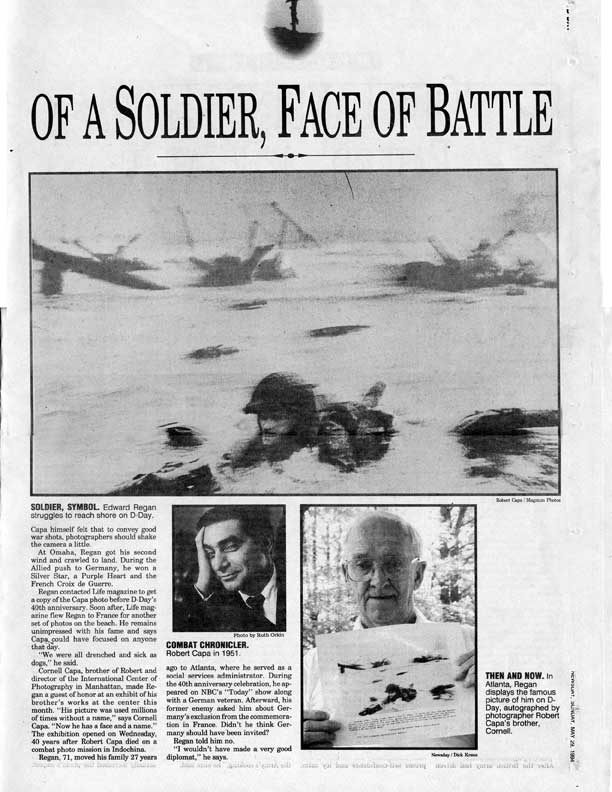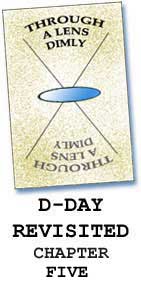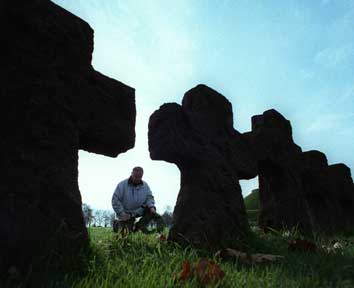PROLOGUE
I was twelve years old when the radio announced that the Allies had
launched the long awaited invasion of Europe that would ultimately
lead to victory and the end of World War II. That day was June 6, 1944
and would come to be known as D-Day.
This June will be the 60th anniversary of that historic event.
I beg your indulgence as I begin the story, about one of the greatest
assignments of my long career as a newspaper photographer.
D-DAY REVISITED
By Dick Kraus
Newsday
Staff Photographer (retired)
CHAPTER
FIVE
After living out of a suitcase for two weeks, it was good to get home,
unpack and get into a full sized shower. I took a couple of weeks vacation
to get back in tune with my family and to take care of neglected chores
at home. Then, I went back to work and spent a considerable amount
of time running my many rolls of color film through our Fuji processor.
I had been careful, while shooting, to label each roll with a number
to correspond with the copious caption notes that I had been taking.
I had to be sure that the film and the notes could be wedded after
processing.
I also made sure that I touched base with the Art Director who was
laying out the special D-Day Anniversary edition since I was told that
I would be involved in the picture selection. He told me that he wouldn’t
be able to begin his layout until he had all of the copy from the writer,
Jim Kindall. I checked with Kindall and he was still sorting through
his notes and it would be weeks before he would begin writing.

| One of several pages in
the D-Day Anniversary Issue that featured head shots
of veterans. Including, at top, Lawrence Peter Berra,
aka Yogi, the former Yankee baseball great. |
|
In
the meantime, I was off of the Photo Department’s
regular schedule so that I could work on the project. There
were
still a myriad of headshots to be made of WW II veterans
whose stories were going to be in the special issue. These
were being compiled and written by other staff reporters
and whenever I got word that an interview had been made,
I would set up an appointment to go and make the requisite
head shot. Most of these were local Long Island vets, many
of whom were now in nursing homes. Some required driving
across the state, as some veterans had moved from Long Island.
Some days I would have a half a dozen heads to shoot, and sometimes there were
none. I would try to work on the film from Normandy and Germany since my Photo
Editors wanted to get a jump on getting them printed. They wisely wanted to avoid
having to get everything done at the last minute as the deadline approached for
the special issue. Plus, I would be back in Normandy at that time, shooting for
daily stories. |
So, a Photo
Editor and I would spend long hours, hunched over a light table,
looking through a loupe at frame after
frame on roll after roll
of film, trying to second guess what would be needed by the Art Director
when he got Jim Kindall’s copy. Every few hours, we would have
to get up from the light table, stretch, then walk down to the cafeteria
for coffee, just to allow our eyes to refocus after squinting through
that magnifying loupe. Since we were picking far more photos than
would finally end up in the paper, we had the darkroom make black
and white
prints. Then, those, which eventually got selected, would be reprinted
in color. (Lord, how much easier this would have been had we been
in this new digital imaging era.) On days when I wasn’t shooting
for the project, I spent writing captions for the photos that had
been printed. All of this took months of effort by our darkroom staff
and
I.
There were days when the photo staff was overwhelmed with
assignments for the daily paper. If I had nothing scheduled,
I would offer to help
out. I saw nothing wrong with that. I’ve known of some of our
staff, who, when given a long-term project to work on, would make
themselves unavailable when they had nothing scheduled. I always
felt that such
an attitude was unfair to the harried staffers who had to pick up
the slack of the missing man.
One day
Kindall called and told me that he had scored a coup. There was
a famous photograph that had appeared in the old Life Magazine
in 1944, right after the Normandy Invasion. It was shot by a
renowned war photographer; the late Robert Capa. The story of
his D-Day photographs has been documented and shown on TV specials
many times since that day. Capa had landed on Omaha Beach with
the first wave of troops and had stood at the shoreline, calmly
making his photos as the fury of the war exploded about him.
All the other photographers lost their film of the initial invasion
when the bag in which it was
being
shipped
back
to
London,
fell
over
the
side
of the
LST
that
was ferrying it to a ship that was headed back. Capa jumped on
a boat that was heading back to England and brought his film
back personally. However, owing to deadline pressure, a darkroom
tech tried to rush the developing process by turning up the dryer
heat, where upon most of the film emulsion melted and slid off
the backing. Only a few frames survived from that historic day.
One of
those showed an unknown American GI, later identified as Edward
Regan, crawling on his belly through the water, trying to get
out of
the line
of
fire
coming
from
the
German guns on the cliffs above the landing zone. The
man had survived the D-Day landing; survived the war and
Kindall had located him living in Georgia. The next day,
the two of us flew to Atlanta and took a cab to the vet’s
home.
| He
told his story and described to us, the sheer panic he felt
as he stepped off his landing craft into the maelstrom
that was happening all around him. He dropped to his stomach
once he reached the shallow water at the shoreline, to avoid
the deadly metal that was flying about in every direction.
He told us how amazed he was at the sight of a young man,
with a cigarette dangling from his lips, standing erect in
the ankle deep water, aiming a camera at him. I made a photograph
of the old veteran, holding a copy of that famous photo. |

Copy of a page from Newsday's
D-Day Anniversary Special Edition.
The top photo, ©Robert Capa/Magnum Photos, shows Edward
Regan crawling through the surf at Omaha Beach on D-Day.
At bottom, left, is Magnum Photographer, Robert Capa,
who made the photo, © Ruth Orkin. The photo at bottom
right, ©Newsday Photo by Dick Kraus, is the shot that
I made of Regan almost 50 years later at his Atlanta,
GA home. |
|
It was getting close to the June date when Jim Kindall and I were
to return to Normandy for the D-Day Anniversary. There were a
million
details to take care of. One of which was making sure that the Hotel
Courtonne remembered that we had booked a couple of rooms
for the two weeks when we would be covering the ceremonies. Before
we had
left, we had been assured that we had two rooms reserved for us.
However, when I made a trans-Atlantic phone call to the Hotel,
no one seemed
to have any knowledge of such arrangements. Damn!!! What the Hell
was going on. Accommodations were scarce as hens teeth when we
had left
there seven months ago. There were surely no rooms to be had
now, with less than a month before the D-Day anniversary. I was pissed
and my lousy command of French made it difficult to try to rectify
the problem. I asked around the newsroom to see if anyone had a better
command of the French language than I. Fortunately a young woman
reporter came to my rescue. I explained the situation, telling
her that the
hotel had promised us a couple of rooms back in November of 1993.
She relayed that information to our French hoteliers and after
some back
and forth discussion, we were told that there would be something
available for us for the two weeks although we would have to
change rooms at
sometime during our stay. That was fine with us. It would be better
than living on a park bench.
Kindall was finally getting his copy to his editor and
to the Art Director. But, every time I went to see the
Art Director, he told me that he
was busy working on daily stories and hadn’t the time to work
on the D-Day Special. This theme continued for weeks and about a week
before I was ready to go back to France, I stopped by to remind him
that I wasn’t going to be around to supply him with my expertise
and input. To which he replied, “Oh, I’ve already laid
out the art for the story. Would you like to see it?”
So much for the photographer having any input, as I had
been promised. Jeez! Why is it so difficult for newspaper
editors to allow any creative
input from the photographers who make the photos? They seem to be
so determined to keep any of their power from slipping
out of their hands.
It wasn’t as though I had any expectations of being able to
tell them that they shouldn’t use this or that photo. Instead
they should use this one and it should be played large and up front.
No,
I would never presume to have that much clout. But, knowing what
happened as I made the photos and Kindall wrote the prose would seem
to put
me in some position of being able to make relevant suggestions as
to which shot would go better with the story.
| Alas,
it just wasn’t meant to happen that way. So, I looked
at the layout and kept my mouth shut as I saw pictures used
that had little relevance to the story, knowing that I had
shots that worked better. He did use a couple of my favorite
photos and ran them large. Especially the one of the German
machine gunner, Franz Goeckel laying a wreath at the grave
of his fallen comrade. |
| ©Newsday Photo by Dick Kraus |
|
I would be back in Normandy when that special edition hit
the streets. I asked Sandy, the Photo Department’s
secretary, den mother and the glue that kept everything
from falling apart, to put aside several
copies for me.
Next thing was to work on our credentials. Kindall had
been in touch with the White House Press Office who was
coordinating American Press
coverage. President Clinton would be attending the ceremonies on
June 6th. But, before he went to Normandy, he would be spending
several days
touring other important World War II battlegrounds in Italy and
Great Britain and meeting with world leaders. The Press Office
said that
they would have credentials for us and we could pick them up when
we boarded the press plane that would accompany the President’s
plane. Problem. We weren’t going to follow the Prez. We had
our own agenda which called for us to fly right to Normandy two
weeks prior
to June 6th and begin doing daily stories on the preparations and
activities that led up to the actual anniversary. One of Newsday’s
White House correspondents would be with the President and her
stories
would be illustrated with wire photos.
After explaining this to the Press Office, they said that
they wouldn’t
mail our credentials to Newsday. They would be carried on the press
plane but they would get them to the Press Office that was being
set up at the American Military Cemetery overlooking
Omaha Beach in Normandy.
We were told that we could pick them up there in plenty of time
to have them when we needed them. I certainly hoped so,
because without
them, we would just be two American Tourists in Normandy, unable
to get anywhere near the action.
It was time to start gathering up equipment and film.
I would be taking a Leaf Transmitter with me so that
I could
transmit my pictures from
my hotel room each night. This was a computerized gadget that fit
into a metal case for ease of carrying. It contained
a small 5 inch tv to
view the pictures. It hooked up to a telephone line and once you
had the picture cropped, color corrected and tweaked,
and a caption written,
you called the home office and they would hook you up to their
computer and in about 20 minutes, your color photo and
caption would appear
on their system. Compared to today’s system of digital cameras,
laptop computers and satellite phones, this was horse and buggy technology.
But, in 1994, it was almost cutting edge. I was using a Leaf I. There
were already Leaf III’s in use, but not for me. Still, it was
better than coming in from the day’s work in the field, and
running to an AP facility to wait my turn to have my film processed
and transmitted.
Life was good and I was ready.
NEXT
MONTH, THE 6TH AND FINAL CHAPTER.
http://www.newsday.com
newspix@optonline.net




